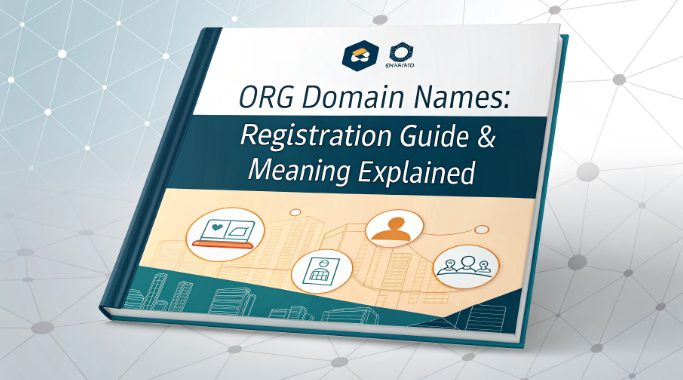Org Domain Names: Registration Guide & Meaning Explained

Navigating the world of .ORG domains requires a deep technical understanding of domain management, server hosting integration, and DNS configuration. This comprehensive guide dives into the technical aspects of .ORG domains, from registration protocols to advanced server integration techniques. Whether you’re deploying an open-source project or setting up a tech community platform, mastering .ORG domain management is crucial for optimal performance.
Technical Deep Dive: Understanding .ORG Domains
The .ORG TLD (Top Level Domain), originally launched in 1985, operates on a robust registry infrastructure managed by the Public Interest Registry (PIR). Unlike conventional TLDs, .ORG employs specialized DNS protocols that tech professionals should understand for optimal configuration. The domain’s technical architecture supports DNSSEC by default, providing enhanced security layers for your digital infrastructure.
Technical Requirements and Registration Protocol
The registration process involves several technical components:
- WHOIS database integration
- DNS propagation mechanisms
- Registry-level authentication protocols
- EPP (Extensible Provisioning Protocol) compliance
- Technical contact verification systems
Advanced DNS Configuration for .ORG Domains
Implementing proper DNS configuration is crucial for optimal performance:
- A Records: Configure IPv4 addressing
- AAAA Records: Enable IPv6 support
- CNAME Records: Establish aliases
- MX Records: Email server configuration
- TXT Records: SPF and DKIM implementation
Integration with Hosting Infrastructure
When connecting your .ORG domain to hosting services, consider these technical specifications:
- Load balancer configuration
- CDN integration protocols
- Cache optimization parameters
- Database connection strings
- Reverse proxy setup
SSL Implementation and Security Protocols
Security configuration for .ORG domains requires specific technical considerations:
# Sample nginx configuration for SSL
server {
listen 443 ssl http2;
server_name your-org-domain.org;
ssl_certificate /path/to/cert.pem;
ssl_certificate_key /path/to/key.pem;
ssl_protocols TLSv1.2 TLSv1.3;
ssl_ciphers ECDHE-ECDSA-AES128-GCM-SHA256:ECDHE-RSA-AES128-GCM-SHA256;
}
Performance Optimization Techniques
Implement these technical optimizations for peak performance:
- DNS prefetching:
<link rel="dns-prefetch" href="//your-org-domain.org"> - HSTS implementation
- Browser caching directives
- Resource compression algorithms
- HTTP/2 protocol enablement
Monitoring and Analytics Setup
Deploy these monitoring solutions for comprehensive domain health tracking:
- DNS query monitoring
- SSL certificate expiration alerts
- Uptime tracking systems
- Performance metrics collection
- Security breach detection
Advanced SEO Configurations for .ORG Domains
Implement these technical SEO optimizations specifically for .ORG domains:
# Sample robots.txt configuration
User-agent: *
Allow: /
Disallow: /private/
Sitemap: https://your-org-domain.org/sitemap.xml
# Sample .htaccess redirect
RewriteEngine On
RewriteCond %{HTTP_HOST} ^www\.(.*)$ [NC]
RewriteRule ^(.*)$ https://%1/$1 [R=301,L]
Technical FAQ and Troubleshooting
Common technical issues and their solutions:
- DNS propagation delays: Implement DNS health checks with dig commands
dig +trace your-org-domain.org - SSL certificate issues: Verify certificate chain integrity
openssl s_client -connect your-org-domain.org:443 -servername your-org-domain.org - Load balancing failures: Check backend server health
curl -I https://your-org-domain.org
Integration with Development Workflows
Establish efficient development pipelines:
- Git deployment hooks
- CI/CD pipeline configuration
- Staging environment setup
- Version control integration
- Automated testing procedures
Cost Analysis and Resource Planning
Technical considerations for resource allocation:
- Bandwidth calculation methods
- Storage requirements analysis
- CPU/RAM utilization metrics
- Backup storage planning
- Traffic scaling projections
Best Practices for Long-term Maintenance
Implement these maintenance protocols for optimal domain health:
- Automated renewal systems
- Regular security audits
- Backup verification procedures
- Performance benchmark tracking
- Documentation update workflows
Advanced Hosting Integration Techniques
For optimal hosting performance, consider these technical configurations:
# Sample Apache virtual host configuration
ServerName your-org-domain.org
DocumentRoot /var/www/html
CustomLog ${APACHE_LOG_DIR}/access.log combined
ErrorLog ${APACHE_LOG_DIR}/error.log
Options Indexes FollowSymLinks
AllowOverride All
Require all granted
Conclusion and Technical Recommendations
Managing .ORG domains requires a comprehensive understanding of domain configuration, hosting integration, and performance optimization. By following these technical guidelines and implementing proper security protocols, you can ensure robust and efficient domain management. Remember to regularly review your DNS configuration, monitor SSL certificates, and maintain proper backup procedures for optimal domain health.
Key Technical Takeaways:
- Implement comprehensive DNS management
- Configure robust security protocols
- Optimize hosting integration
- Maintain regular monitoring systems
- Follow proper backup procedures
For technical professionals managing .ORG domains, staying updated with the latest domain management practices, hosting integration techniques, and security protocols is essential for maintaining a robust digital infrastructure.

